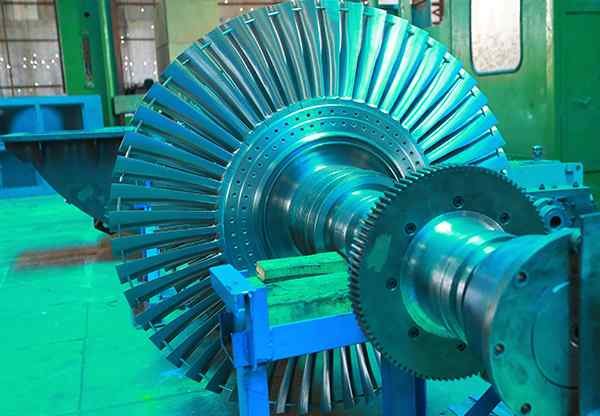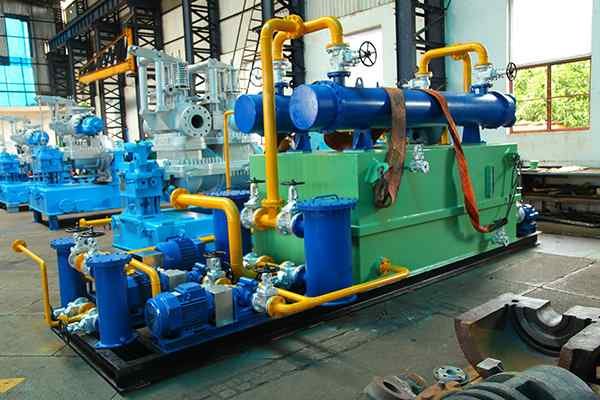The steam turbine, one of the greatest inventions in the field of mechanical engineering is an energy conversion device that converts thermal energy extracted from steam into mechanical energy. The modern Steam turbines was invented in the late 19th century by Charles Parsons. In those days the demand for efficient energy conversion devices was high due to the industrial revolution.
A turbine is a specially designed device that makes use of the kinetic energy of fluids and converts them into rotational motion. The rotational motion is used to generate various forms of power and the fluids may be water, steam, air, combustion gases, etc. There are different types of turbines designed for various applications. Most of the turbines are utilized in electrical energy generation and propulsion systems. The design of the turbine configuration is such that the kinetic energy of the fluids gets multiplied within the casing and the energy is extracted by the turbine from the steam to give maximum output power.
Different types of turbines include steam turbines, wind turbines, water turbines, gas turbines, etc. Among these steam turbines and gas turbines are popularly used in energy generation and propulsion systems respectively.

Condensing, extraction, and back-pressure are three basic types of steam turbines.
A condensing steam turbine has the ability to extract total inlet energy to give maximum output energy. Hence these turbines are utilized in power generating sectors. Straight condensing, extraction condensing, bleed condensing, double controlled extraction condensing, injection condensing, and re-heat condensing are other classifications of condensing turbines.
Condensing steam turbine is the leading steam turbine among others. Generally, this kind of steam turbine is used for large drive applications for maintaining a power rating limit(above 8 MW). To control the condition of the vacuum these steam turbines drain the condensers. With some tubes of cooling water, the steam is compressed into the water in the condenser.

When the near-circling cooling water condenses the steam into the condenser, the vacuum arises. In less atmospheric pressure, a small quantity of air is enough to leak the system, a comparable compressor is used to extract the gases which are non- condensable from the condenser.
The progress of this type of turbine assembles maximum mechanical power and capability from the steam supply. Condensing steam turbines are extravagant, gigantic, complicated, and non-applicable for mechanical drive function. In low pressure, air can leak through the system of condensing steam turbine.
Chola Turbo is proud to be one of the leading suppliers of condensing steam turbines in Mexico to boost its energy sector.
A backpressure steam turbine ejects the steam at a pressure above atmospheric pressure. They are most suitable for mechanical drive applications like drivers or compressors.
The Back-pressure steam turbine is the most satisfactory machinery for mechanical drive applications, such as the operator of compressors or pumps. The back-pressure steam turbine can exhaust steam in high percentage atmospheric pressure. The discharge pressure is generally settled by the particular function of the steam. The process of reducing pressure is periodically used in small and large pressure operations, for example, overheating of the system.
In the industrial process, small steam turbines are used to spin the material that runs for long period. For maximum efficiency of the mechanical power generation, the steam should get expanded at definite pressure.

For distributing 10 barg steam, it can reduce almost half the power that could be provoked when the inlet steam system is around 50 barg and 420. c, commonly for small and medium steam turbines.
The combination of the mechanical steam condensing power turbine and the back- pressure steam turbine is essential for any power-to-heat output supplied.
An extraction steam turbine is a third type of steam turbine. It has single or multiple openings in its casing for the extraction of a portion of steam at some intermediate pressure in order to increase efficiency. The extraction turbine has several roles for extracting a separate portion of the steam in some transitional pressure. This type of turbine is used for the purpose of processing. The process of extracting may be permitted for naturally regulated, it depends upon the design of the turbine.
An extraction turbine allows better steam outflow to generate mechanical power. A few extraction points may be combined with some specific steam turbine but each has different heating and temperature facility because in a plant quantity is matter heavily. These facilities are needed to determine the extent of steam extraction.

When a multiple steam generation system has been used in a variety of pressure because of plant intricacy and needs to scope the thermal efficiency or historical existence. These steam turbines are well-known as admission steam turbines. Using a complicated steam turbine with extraction and admission is not applicable for maintenance with a few megawatts of power and complicated patterns with variable- load, variable-speed steam turbine operation.
Steam turbines are an alternate device for steam engines due to their high efficiency and multiple advantages. Nowadays steam turbines are utilized in various applications that demand power generation and power conversion. Power generation, propulsion systems, and distillery plants are the areas where turbines play an important role. After the industrial revolution, conventional steam engines were replaced with steam turbines. Steam turbines are one of the reasons for the efficient use of heat energy in industries.
The steam turbines were introduced in the power generation sector as they were highly able to create a rotatory motion which in turn continuously rotated the shaft of the generators. It replaced the conventional piston-based steam engine because of its greater thermal conversion efficiency and high power-to-weight ratio. Initially, steam turbines were used in power plants, and later they gained importance in various power conversion devices too.

The steam turbine made power production cheap and shaped the efficient use of thermal power through its multiple stages of expansion. Steam turbines have become an integral part of all modern power plants and industries. They are also used in locomotives and propulsion systems. Currently, steam turbines are utilized in the chemical industry, waste plants, oil and gas plants, heating and cooling systems, sugar mills, and other distilleries. Condensing, extraction, and back-pressure are three types of steam turbines.
The turbine blades are constructed to control the speed, direction, and pressure of the steam. In large-scale turbines, dozens of blades were attached to the rotor in different sets. Every set of blades called stages helps to extract the energy from the steam when the pressure is at a tremendous level. The blades of the turbine help to reduce the force of the steam and also improve the overall output of the turbine.
Modern steam turbines can reach an efficiency of more than 70 percent. The main reason behind the high efficiency of steam turbines is using at stages. The output steam which is at lower temperature and pressure is again fed to the boiler for heating, this process is called reheating. The steam again gains sufficient heat and pressure which is again sent to the turbine inlet.

Steam turbines are always operated in a system that involves heat and reheating of water. The system includes cogeneration plants, thermal power plants, etc.
Steam turbines are highly capable to create rotatory motion that is best suited to driving an electric generator. Steam turbines that are connected to an electric generator to produce electric power are called turbo generators. Thermal and nuclear power plants use steam turbines to transform heat energy into rotational motion. The main reason why steam turbines are still used today is that there is no alternative device to steam turbine performance. Steam turbines replaced conventional steam engines in the 19th century during the period of the industrial revolution. Steam turbines can touch an efficiency of up to 90 percent if operated in stages. For a single-stage operation, the efficiency is quite low at 40 percent. Along with this, they have a high power-to-weight ratio and are capable of operating at a wide range of operating speeds.

Chola Turbo steam turbines in Indonesia
Chola Turbo has exported more than a dozen of powerful steam turbines to Indonesia in the last few years. CTMI has a good customer base in Indonesia helping industries and other power sectors to achieve their goal of fulfilling power demands in the country. The CTMI steam turbines are manufactured with a robust design and cutting-edge technology giving high output power and better efficiency. The standard material used in the turbine body enables the steam turbine to withstand high temperature, pressure, and vibration and makes it a high-performance machine.
The modern steam turbines are getting more powerful and the demand is also high due to the development in the power infrastructure. The steam turbines used for power generation can reach an efficiency of up to 90 percent by operating in stages. Chola Turbo Machinery International Private Limited has also worked with steam turbine manufacturers in Russia to design high-performance turbine blades for powerful steam turbines.
The Chola Turbo was also present at Nigeria Oil & Gas Exhibition(NOG) 2022 which was held between 05th to 07th July 2022 in Abuja, Nigeria. The business and technical members of the Chola Turbo team had multiple discussions with the CII business delegation and other manufacturers of steam turbines in Nigeria at NOG 2022. The NOG 2022 offered the platform for trade and investment opportunities in Nigeria in the power sector.
The steam turbines have helped the power sector to operate the machine efficiently. The thermal power plants and Co-generation plants operate steam turbines in stages and utilize the heat energy to the maximum extent to reach an efficiency of more than 90 percent. Obviously, turbines are one of the greatest inventions of mankind that has revolutionized the power sector.
